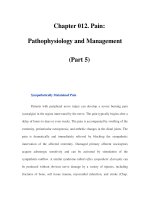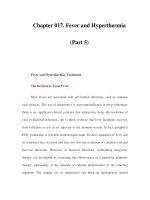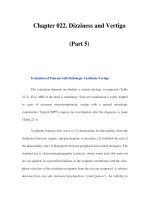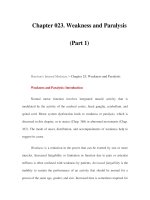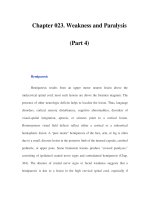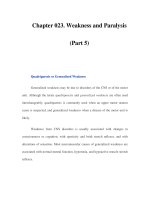Chapter 047. Hypercalcemia and Hypocalcemia (Part 5) pps
Bạn đang xem bản rút gọn của tài liệu. Xem và tải ngay bản đầy đủ của tài liệu tại đây (83.11 KB, 5 trang )
Chapter 047. Hypercalcemia
and Hypocalcemia
(Part 5)
Vitamin D deficiency, impaired 1,25(OH)
2
D production (primarily
secondary to renal insufficiency), or, rarely, vitamin D resistance also cause
hypocalcemia. However, the degree of hypocalcemia in these disorders is
generally not as severe as that seen with hypoparathyroidism because the
parathyroids are capable of mounting a compensatory increase in PTH secretion.
Hypocalcemia may also occur in conditions associated with severe tissue injury
such as burns, rhabdomyolysis, tumor lysis, or pancreatitis. The cause of
hypocalcemia in these settings may include a combination of low albumin,
hyperphosphatemia, tissue deposition of calcium, and impaired PTH secretion.
Clinical Manifestations
Patients with hypocalcemia may be asymptomatic if the decreases in serum
calcium are relatively mild and chronic, or they may present with life-threatening
complications. Moderate to severe hypocalcemia is associated with paresthesias,
usually of the fingers, toes, and circumoral regions, and is caused by increased
neuromuscular irritability. On physical examination, a Chvostek's sign (twitching
of the circumoral muscles in response to gentle tapping of the facial nerve just
anterior to the ear) may be elicited, although it is also present in ~10% of normal
individuals. Carpal spasm may be induced by inflation of a blood pressure cuff to
20 mmHg above the patient's systolic blood pressure for 3 min (Trousseau's sign).
Severe hypocalcemia can induce seizures, carpopedal spasm, bronchospasm,
laryngospasm, and prolongation of the QT interval.
Diagnostic Approach
In addition to measuring serum calcium, it is useful to determine albumin,
phosphorus, and magnesium levels. As for the evaluation of hypercalcemia,
determining the PTH level is central to the evaluation of hypocalcemia. A
suppressed (or "inappropriately low") PTH level in the setting of hypocalcemia
establishes absent or reduced PTH secretion (hypoparathyroidism) as the cause of
the hypocalcemia. Further history will often elicit the underlying cause (i.e.,
parathyroid agenesis vs. destruction). By contrast, an elevated PTH level
(secondary hyperparathyroidism) should direct attention to the vitamin D axis as
the cause of the hypocalcemia. Nutritional vitamin D deficiency is best assessed
by obtaining serum 25-hydroxyvitamin D levels, which reflect vitamin D stores.
In the setting of renal insufficiency or suspected vitamin D resistance, serum
1,25(OH)
2
D levels are informative.
Hypocalcemia: Treatment
The approach to treatment depends on the severity of the hypocalcemia, the
rapidity with which it develops, and the accompanying complications (e.g.,
seizures, laryngospasm). Acute, symptomatic hypocalcemia is initially managed
with calcium gluconate, 10 mL 10% wt/vol (90 mg or 2.2 mmol) intravenously,
diluted in 50 mL of 5% dextrose or 0.9% sodium chloride, given intravenously
over 5 min. Continuing hypocalcemia often requires a constant intravenous
infusion (typically 10 ampuls of calcium gluconate or 900 mg of calcium in 1 L of
5% dextrose or 0.9% sodium chloride administered over 24 h). Accompanying
hypomagnesemia, if present, should be treated with appropriate magnesium
supplementation.
Chronic hypocalcemia due to hypoparathyroidism is treated with calcium
supplements (1000–1500 mg/d elemental calcium in divided doses) and either
vitamin D
2
or D
3
(25,000–100,000 U daily) or calcitriol [1,25(OH)
2
D, 0.25–2
µg/d]. Other vitamin D metabolites (dihydrotachysterol, alfacalcidiol) are now
used less frequently. Vitamin D deficiency, however, is best treated using vitamin
D supplementation, with the dose depending on the severity of the deficit and the
underlying cause. Thus, nutritional vitamin D deficiency generally responds to
relatively low doses of vitamin D (50,000 U, 2–3 times per week for several
months), while vitamin D deficiency due to malabsorption may require much
higher doses (100,000 U/d or more). The treatment goal is to bring serum calcium
into the low normal range and to avoid hypercalciuria, which may lead to
nephrolithiasis.
FURTHER READINGS
Bilezikian JP, Silverberg SJ: Asymptomatic primary hyperparathyroidism.
N Engl J Med 350:1746, 2004 [PMID: 15103001]
Farford B et al: Nonsurgical management of primary hyperparathyroidism.
Mayo Clin Proc 82(3):351, 2007 [PMID: 17352371]
Finkelstein JS, Potts JT Jr: Medical management of hypercalcemia, in
Endocrinology, 5th ed, LJ DeGroot, JL Jameson (eds). Philadelphia, Elsevier,
2006
Kifor O et al: Activating antibodies to the calcium-sensing receptor in two
patients with autoimmune hypoparathyroidism. J Clin Endocrinol Metab 89:548,
2004 [PMID: 14764760]
Marx SJ: Hyperparathyroid and hypoparathyroid disorders. N Engl J Med
343:1863, 2000 [PMID: 11117980]
Stewart AF: Hypercalcemia associated with cancer. N Engl J Med 352:373,
2005 [PMID: 15673803]
Thakker RV: Genetics of endocrine and metabolic disorders: parathyroid.
Rev Endocr Metab Disord 5:37, 2004 [PMID: 14966388]
